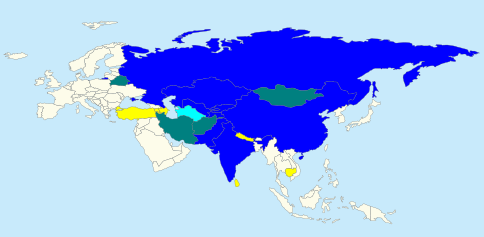What is the issue?
- The recent “Shanghai Cooperation Organisation” (SCO) summit in Qingdao (China) was the 1st for India and Pakistan as full time members.
- SCO has risen as an internationally important grouping due to the profile of its members and the under-performance of other international forums.
What is the history of SCO?
- The SCO grew out of the Shanghai Five grouping (Russia, China, Kazakhstan, Tajikistan and Kyrgyzstan), which was set up in 1996.
- While its initial goal was t0 resolve boundary disputes in the region, it has evolved into a security and economic cooperation block over the years.
- In 2001, Uzbekistan was also admitted as a member and the organization was re-christened as “Shanghai Cooperation Organisation” (SCO).
- While India and Pakistan have been observers since 2005, in the 2017 SCO meet, both were admitted as full members.

Blue: Member countries, Green: Observers Countries, Yellow: Dialogue Partners
Why is SCO critical for India?
- Significance - The admission of India and Pakistan has expanded the geographical, demographic and economic profile of the SCO.
- SCO now has about half the world’s population and a quarter of its GDP and its boundary extend southwards to the Indian Ocean.
- The SCO’s relevance for India lies in geography, economics and geopolitics as its members occupies a huge landmass adjacent to India’s neighbourhood.
- Central Asian SCO members border Afghanistan and a narrow strip of land separates southern Tajikistan from Pakistan-occupied Kashmir.
- Logistics - When you have complicated relations with your neighbours, it makes sense to strengthen relations with your neighbours’ neighbours.
- With Pakistan joining the Organisation and Afghanistan and Iran knocking on the doors for membership, the logic of India’s membership becomes stronger.
- Since the break-up of the Soviet Union, the optimal development of India’s relations with Central Asian countries has been constrained severely.
- Factors like lack of overland access through Pakistan, Afghanistan and Iran, and politico-security concerns proved difficult to overcome.
- With new multimodal transport corridors now envisaged through Iran, there are again prospects of invigorating trade and investment links with this region.
What are the political equations within SCO?
- In the formative years of the SCO, Russia pushed strongly for India to join it, to somewhat balance China’s economic dominance in Central Asia.
- China’s own insecurities made them obstruct Indian entry into the grouping back then, which help it maintain its clout over the organisation.
- Currently, with China having grown confident with a strong economic might, it seems to have grown more inclined to accept Indian membership.
- Notably, the central Asian region is the hotbed for China’s ambitious “Belt and Road Initiative” and Indian participation will help further this.
- Nonetheless, it has secured the simultaneous admission of Pakistan into the SCO as a counterbalance to India’s motives.
- In this context, India too has managed to carve out a niche role for itself in the region alongside China and Russia through active diplomatic outreaches.
- Also, thus far, Indo-Pak equations within the forum have been pleasant, betraying naysayers who speculated turbulence due to the new entrants.
What are the aspects to lookout for India and Pakistan in SCO?
- Border Dispute - Russian President Putin has suggested that cooperation within SCO may pave the way for an India-Pakistan rapprochement.
- He also recalled that SCO membership had facilitated resolution of China’s boundary disputes with Russia and Central Asian countries.
- While the circumstances are not comparable, and Indo-Pak disputes are not merely border related, the hope expressed is nonetheless a positive sign.
- Significantly, China made substantial concessions to settle its boundary disputes with Russia and Central Asia, in pursuit of larger strategic objectives.
- Regional Anti-Terrorist Structure - RATS as a principle organ of SCO, coordinates for security and stability, through intelligence-sharing.
- India and Pakistan, which exchange mutual recriminations in such matters, have to find ways of cooperating in the RATS.
- Defence cooperation - India has agreed to participate in the SCO’s counter-terrorism military exercises in Russia later this year.
- Here, Indian and Pakistani troops will likely operate together, an event that has never occurred before.
- Reconciling Indian and Pakistani perspectives in the SCO’s initiatives on Afghanistan would be yet another challenge.
How does the future of SCO look?
- Dilution - The expansion of SCO has diluted its unanimity on hitherto shared perspectives on certain critical issues.
- Notably, India and Pakistan aren’t signatories of “Nuclear Non-proliferation Treaty”, a provision that was held in high regard by SCO.
- India’s reservations on China’s BRI are accommodated by excluding the project from the list of endorsed programs of SCO.
- Even the anti-terrorism initiatives and documented statements are being diluted cautiously to accommodate divergent opinions on the same.
- Eastern Grouping - The structural strengthen and diversity of the group as an alliance of eastern power has seen SCO rise as a potent counter to the west.
- While some seen this as a continuation of cold war political equations of the Soviet Block, there has been a drastic change in the rhetoric.
- Notably, the anti-west stands of SCO are not stringently pronounced like the Soviet era, and the U.S. has a working relationship with many SCO members.
- Chinese Dominance – The worldwide retreat of U.S. under the inward looking regime of Mr. Trump is paving the way for the stoic rise of China.
- SCO like organisations are seeing China consolidate its structural base in the international forum, forcing even Russia to fall in line.
Source: The Hindu
